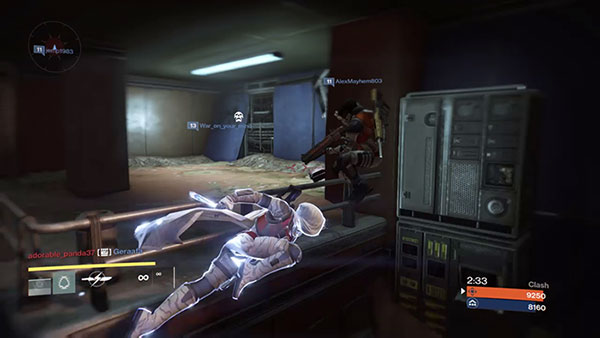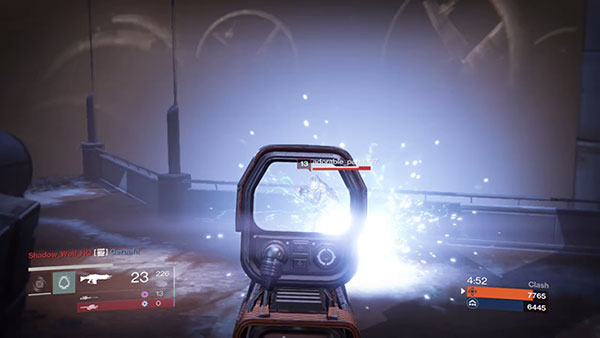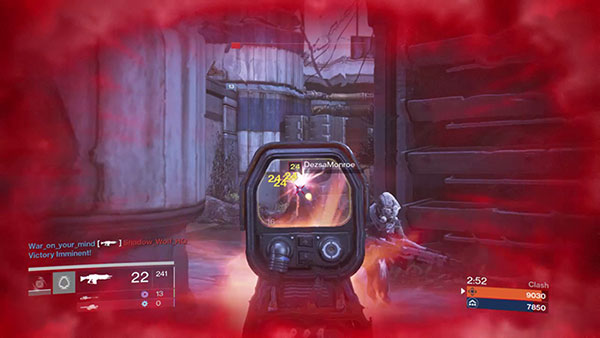
Featured Blog | This community-written post highlights the best of what the game industry has to offer. Read more like it on the Game Developer Blogs or learn how to Submit Your Own Blog Post
Destiny and the Modern Competitive FPS Game Design Paradigm.
Analysis of modern competitive first person shooter design trends using Destiny as an example.

After playing the alpha and beta, I'm now enjoying retail Destiny on PS4. It's got some neat mechanics that distinguish it from the typical CoD/BF flavor of FPS that dominates AAA. However, I'm not going to talk much about what it does well -- this isn't a review. I'm mostly using this as an opportunity to ramble about FPS game design in the context of current competitive FPS trends and I think Destiny represents those trends well in the PvP modes. Destiny has a large PvE aspect to it, but it's largely outside the scope of this post -- this is focused on things relating to competitive multiplayer.

Interface Matters
Over the past 15 or so years, FPS games have largely shifted from PC-centric to console-centric. Even when AAA FPS games have a PC version, they typically design for the controller first -- controller-centric games can feel fine with kb/m, but a game designed for kb/m can feel bad on a controller (Counter-Strike: Global Offensive comes to mind). When they're trying to reach the broadest audience possible, it makes sense to prioritize the controller.
To compensate for the lack of speed/precision with analog sticks, there's a lot of effort to slow down combat so that it's easier to track targets using a controller. Simply reducing movement speed to a crawl would make gameplay outside of combat feel awful, so they turn to some clever mechanics in order to slow down combat without dragging everything else down with it.
Sprinting - because you typically holster your weapon while sprinting, this helps speed up noncombat while still allowing the default movement to remain slow during combat.
ADS (aiming down sights) - the tilt range on analog sticks is small, so it's hard to find a good balance for sensitivity that allows the player to be able to track their target and also turn around at a reasonable speed. ADS helps this by basically letting the player toggle their sensitivity and the games usually enforce this by making the accuracy boost you get from ADS necessary to win firefights. It's also often accompanied by further reduction in movement speed making players even easier to track in combat.
Radar - even with ADS, turning around with an analog stick still takes too long if you're using a sensitivity low enough to be able to aim well. It's frustrating to have someone attack from behind and not be able to turn quick enough to fight back, so radar helps reduce the need to turn around quickly by having the player always know what direction the threat is coming from. In destiny, you have to keep a constant beat on the radar -- once I really started paying attention to the radar, it was extremely rare to have someone sneak up on me. Crouching makes you less visible on radar but it also lowers your movement speed to a pathetic crawl that ruins your ability to advance on an enemy, so it's mostly reserved for defending/camping. On principle, I personally don't really like the idea of having to keep your eyes glued to a radar -- it just isn't fun and I think it's generally better to have the player watching their environment. It also reduces the need for teamwork -- multiple people can cover more directions than a single player to guard against potential flanking, but if everybody knows the threat is coming from one particular direction, it's more optimal to all face in the same direction to overwhelm the known threat and not worry about a flank. Destiny's Hunter class has a stealth ability that reduces your radar visibility but I'm not sure yet if I'd call it a game changer.
Quick Melee - in these games, you typically just tap your dedicated melee button and it executes a melee attack regardless of what weapon you have equipped. Every technique mentioned above incentivizes players to use lower sensitivities, but that puts you at a disadvantage when you need to turn more quickly like when someone is up in your face. Without this quick, lethal melee system, close quarter combat would be clumsy chaos. Lethal melee attacks that can be executed at any time brings some order to that chaos -- instead of aiming wildly to try and shoot the enemy flying across your screen, you simply smack them (often assisted by very strong auto-assist). Not only does this elegantly address the sensitivity range design challenge, but it feels really satisfying. I think the drawback, however, is that it reduces variety. Every player is extremely lethal at melee range which diminishes the opportunity for designers to craft specialized melee-centric playstyles -- I think it's more interesting if you have some players avoid CQB and other players thrive in it based on their loadout and playstyle.

These mechanics naturally fit better with realistic games, which might partly explain why CoD/BF formula has become so popular. To their credit, console games are starting to do a bit of exploring in terms of more interesting movement mechanics without sacrificing their controller-friendliness -- Titanfall and Destiny come to mind. But as someone who grew up playing PC FPS in the late 90s and early 00s, I can't help but feel like controller-centric FPS games are still catching back up to the golden age of PC FPS. It's not that I don't think there's room for console-focused FPS games -- there obviously is -- but I think the way FPS devs have focused on the console audience, even if there's a PC version, has really restricted variety in FPS game design.
Accessibility Dogma
A criticism I have of many FPS games is that they feel monotonous, and Destiny is no exception. I attribute a lot of this to the desire to fill feature checkboxes and make the game quick and easy to pick up and play.
Drop In Drop Out Matchmaking - FPS games have historically been very easy to join/leave -- contrasting with genres like RTS, in an FPS you'd expect to freely join/leave servers regardless of the state of the match. I think that expectation has carried over into the modern age of matchmaking where players expect the matchmaking system to find them a game quickly and not be penalized much for leaving early. Consequently, a player that joins halfway through can't be at a permanent disadvantage. This excludes the designers from fully exploring the kind of game mechanics that stretch through the whole match, like exp/items in MOBAs. I think these sort of 'rising tension' mechanics really benefit these games in respect to eSports -- the first 5 minutes of the game are very different than the last 5 minutes. FPS games have mostly stayed away from these mechanics, often for valid reasons, but the consequence is they're more repetitive and less interesting to spectate. Although Counter-Strike's money system is pretty light-handed, I think it's one of the reasons that game has seen more success in eSports. I don't necessarily think it's optimal to copy/paste these MOBA mechanics into an FPS (see Monday Night Combat and upcoming Battleborn), but I do think it's an area that I think has a lot more room for exploration. However, that would rely on an expectation closer to RTS/MOBAs, where you're expected to play a whole match from start to finish with the same group of players -- can FPS players adapt to that? I hope so, because I also think the consistency with casual/competitive play (playing by the same rules/formats) afforded by that sort of setup is another reason why the MOBA eSports scene has been so strong. I think there's probably room for new ideas in this matchmaking space to make that less of a pain point for traditional FPS players.
Spawn System - CoD's spawn system seems to be the standard nowadays and Destiny seems to use something similar. It's made to quickly drop you back into the action with your teammates wherever they happen to be and it does that well, but I personally think it hurts level design and game flow. The level designer has less control over choke points and map flow when you can spawn virtually anywhere at any time -- contrasting with a game like Counter-Strike, where dependable constants (spawn locations and round format) allow the level designer to meticulously fine tune choke points and flow to replace randomness with open but deliberate variety in strategic possibilities. As a player, it's also harder to get your bearings because the enemy could spawn from virtually any direction -- you might think you've cleared an area and consider it safe, but an unlucky enemy spawn ruins that whole dynamic. Throughout the match, you're constantly being dropped into random locations to shoot at the nearby enemies all around you and it feels like the same thing happening over and over again. The pace of the game barely fluctuates. This is a criticism I have of many games and isn't a problem exclusive to Destiny. I recognize that other players might prefer that style, but it gets boring for me personally and I think it's generally less entertaining to spectate.
Lots of Game Modes - FPS players do love having a variety of game modes. Many see it as a value proposition -- they want the most bang for their buck and see game modes as a key measurement of value (along with the number of maps). Unfortunately, this pressure to offer multiple game modes has an unintended consequence on game design. In terms of level design, there's two strategies. You could design and optimize maps exclusively for specific game modes -- this rarely happens because it's expensive. If you have 12 maps divided between 6 game modes, that's only 2 maps per mode -- players, especially if they have a strong preference for a specific game mode, will want more maps for each mode. And worse, if a mode is rarely played, all the work that went into those maps is wasted. Counter-Strike comes to mind again -- hostage rescue gets some use in pub play, but competitively play is exclusively bomb defusal -- Counter-Strike's VIP mode was so unpopular that it was scrapped in CS:GO. Most of the playtime occurs on a few of the community's favorite maps and the rest get largely ignored. You could always argue that it's always nice to have options, but developers will always be pressured to reduce wasted work. So instead, maps are usually designed to work with multiple game modes. Similar to the spawn system, this negatively impacts level design -- the level designer is forced to compromise over and over again in order to make the map function in each game mode. A map that flows well for CTF might have wasted space for TDM. This also creates pressure for game modes to be simplified in order to be more compatible with each other on the same maps. Destiny doesn't even have CTF -- all of Destiny's modes are variants on team deathmatch. Control/Salvage add some lightweight objectives, but the scoring system is still heavily weighted toward getting kills so it's often more optimal to ignore the objectives and just focus on the enemy. If everything is a compromise, nothing is optimal.
The grind - I'm not talking about the exp/loot grind (yet). I'm referring to the feeling of having your contributions to the team feel diluted. Outside of supers, I don't think there's enough room for superstars and game-changing plays by individuals in Destiny when everyone is around the same skill level. I think this partly goes back to the my earlier points regarding reduced variety in weapon mechanics and it applies to many modern games. Every player is given a very similar set of tools (all 3 classes use the same weapons) and the weapons mostly differ in small ways like fire rate and recoil spread, so there's fewer opportunities for counter-plays and specialized play styles -- everybody is more or less equally effective against everybody else. More specialized weapons like shotguns and sniper rifles take up a secondary slot and don't exclude the player from having their bread and butter primary, so these specialized weapons rarely carry meaningful disadvantages (having a shotgun in your loadout doesn't prevent you from being effective at medium/long ranges). This is in sharp contrast to MOBAs where heroes can act as counters to each other and you need a well balanced team. Crafting counter-plays into the multiplayer sandbox opens up more variety in the form of team strategies. Teams can plan their composition (of strengths and weaknesses) and coordination in ways that influence their overall strategy as a whole, which the other team can counter with their own team strategies, creating an interesting and dynamic metagame. In Destiny, this sort of overarching metagame is largely absent -- apart from maybe sniping (as a form of map control), there are few roles for players to play other than "be good at killing enemies." I could see some potential with the Titan Defender subclass, but I mostly see Striker being used -- probably because most of the modes don't strongly emphasize objectives so the enemy can simply choose not to engage with the bubble (Defender is probably VERY useful for Salvage). My favorite game mode is Skirmish, which is a 3v3 TDM mode that allows players to revive teammates -- I also like Salvage but it's only available on certain weekends. Being able to revive teammates really emphasizes strong team coordination and reduces the negative impact of spawn system. Limiting it to 3v3 gives each individual more potential impact on match outcome, so you feel more valuable. Allowing powerplays reduces the negative feelings associated with being on the losing team -- you feel less like you're on a sinking ship because you can still make interesting things happen on an individual level. Embracing superstars and power plays also makes it more exciting for spectators.
Especially with the explosion of mobile gaming, accessibility has become a key focus in game design. The intention is noble -- to get more people playing. But I worry we've lost sight of what makes games worthwhile -- it's not their ability to become addicting and consume our time with loot, exp grinds, and unlocks -- in the case of competitive multiplayer, a game's value comes from motivating players to improve their skills by providing interesting tools and ways to outsmart and outplay their human competitors.
This attempt by AAA FPS games to simplify and remove confusion has resulted in what I see as a lack of competitive depth. To compensate, I think today's FPS games rely too heavily on exp/loot progression systems to keep the player motivated and improve retention. I think these sort of systems have a place in these games -- having something concrete for the player to strive for is nice, but there can come a point where they act more as a crutch. I find myself asking "would I still be playing this game if the loot system removed?" -- if the answer is no, is the game actually worth investing more time into? What's the payoff?
I've never been a big MOBA player, but I love what they're doing. They prove that we, the developer community, still have a lot to learn about what allows games to be popular. Earlier this year, League of Legends reported having 27 million daily players. That's not total number of players -- that's 27 million people logging on daily (67 million different players log in each month), which is absolutely huge. That hints at two big things. First, it shows you can have an incredibly deep and complex game with a steep learning curve without assuming a financial flop by not being accessible to every player imaginable -- accessibility certainly has value, but it's not the primary end goal and there's room to explore other ways to keep players playing. Second, it shows that PC gaming is a huge market that is mostly ignored -- AAA has noticed what MOBAs are doing, but their answer is more MOBAs. MOBAs obviously have a lot of good lessons to learn from, but I have a feeling these PC gamers might want some variety.. and console ports aren't doing the job.
Crafting Player Motivations
Multiplayer achievements (and Destiny bounties) can help a game by motivating the player to explore and master mechanics they might have been otherwise ignoring. Unfortunately, they can influence player behavior away from what would be the optimal strategy for that particular match/moment (e.g. you're more likely to make bad melee attempts if you're trying to get a melee attack achievement/bounty). This is especially problematic when the same set of bounties are given to everyone at the same time -- when the queen bounties first appeared, crucible instantly became overcrowded with people exclusively using hand cannons and scout rifles trying to get headshots for their bounties. One possible improvement would be to distribute different bounties to different players and hopefully do it in a way that can maintain a somewhat normal match dynamic that is more representative of how the game should optimally be played without the influence of bounties and achievements.
Destiny is a loot game but the next segment could also apply to games that only have cosmetic loot. People have a perception that there's a pattern with the distribution of crucible loot. Top players seem to have a smaller chance of getting loot. If this pattern is true (at this point I'd describe it as unconfirmed), I could see three likely scenarios.
Scenario 1 is that they want to help prevent people at the bottom of the scoreboard from getting demotivated and stop playing, so they give them rewards for their effort.
Scenario 2 is that it's not based on scoreboard placement, but based on current gear/level and better geared players simply appear at the top of the scoreboard more often. After level 20, your level becomes representative of your gear, so whether it's based on gear or level is pretty insignificant. This would allow lesser-geared players to catch up faster in terms of gear and I've seen this argument be made by players.
Scenario 3 is that it's actually random but players are just more likely to remember instances where the top player gets less loot -- it goes against their expectations and stands out to them as a problem.
Both the first and second scenarios would be driven by good intent, but I think it's terrible to punish the top players. Putting in all that effort to get to the top and then be left out of the loot feels awful and is demotivating. Just reading on forums about the possibility that top players get less loot makes me want to play crucible less. It disrespects the players time. Even if this is all in people's heads (which would be my vote), that's still a perception problem that can and should be addressed.
I generally think better performance should be given better rewards -- after a while, top players will already have the best loot they can get from crucible rewards so them getting the same good gear won’t hurt anything, but at least they get something (they can salvage it for parts/currency). If it's resulting in too much inequality in terms of gear and lower tier players are quitting, just don't show the loot other players get; don't give players, no matter their skill, something to be jealous of. Seeing other players wearing the loot should be enough to motivate them to strive for it and they'll pay more attention to playing the game instead of trying to play the loot system.
In this GDC talk about Hearthstone they talk some about emotion-driven design. I'm wary of letting emotional design overshadow competitive game design, but any instance where you can improve emotional design without hurting competitive value should be exploited fully -- it simply improves player experience. While Bungie hasn't talked about crucible loot specifically, they have spoken about improving the 'reward celebration' aspects of loot and I imagine they'll continue improving these aspects over the life of the game.

In many ways, modern first person shooters have made a lot of improvements over the years. I'm not saying they're doing it wrong, but I think there are more right answers that we can play with that aren't being explored right now. I'm not trying to replace so much as I am trying to expand what first person shooters can do. Some of the older tools in our designer toolbox should be reexamined and we shouldn't stop trying to search for new tools. Exp grinds and unlock rewards might be an easy way to get player retention, but we shouldn't get complacent with our actual game design under the fear that we'll confuse players. We can learn from what has worked in the past, but we shouldn't be afraid to seek out what will work in the future.
Read more about:
Featured BlogsAbout the Author
You May Also Like









